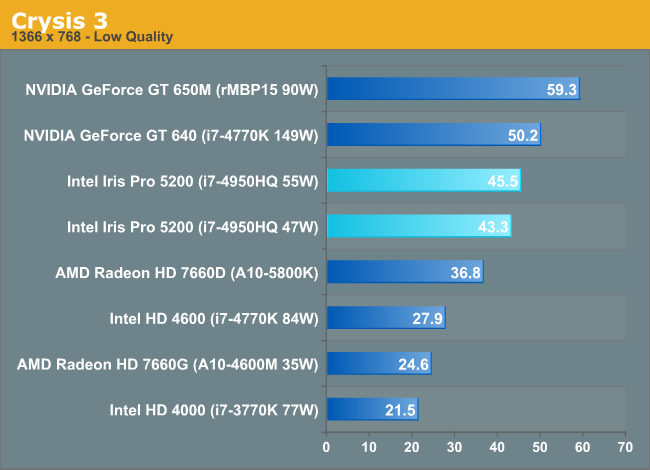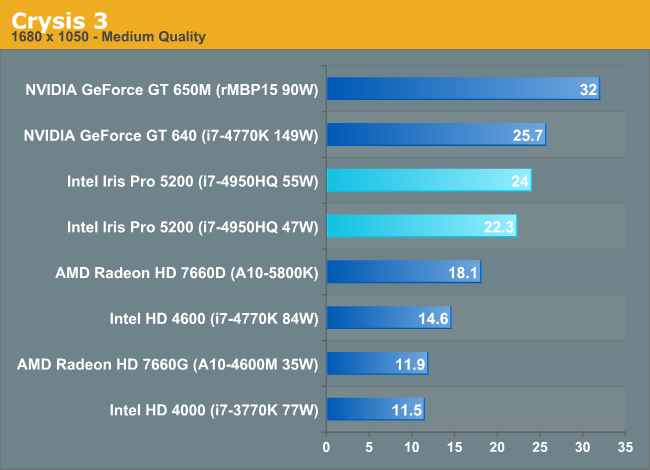Intel Iris Pro 5200 Graphics Review: Core i7-4950HQ Tested
by Anand Lal Shimpi on June 1, 2013 10:01 AM ESTCrysis 3
With Crysis 3, Crytek has gone back to trying to kill computers, taking back the “most punishing game” title in our benchmark suite. Only in a handful of setups can we even run Crysis 3 at its highest (Very High) settings, and the situation isn't too much better for entry-level GPUs at its lowest quality setting. In any case Crysis 1 was an excellent template for the kind of performance required to drive games for the next few years, and Crysis 3 looks to be much the same for 2013.

All of these GPUs need to run at low quality settings to get decent frame rates, but Iris Pro is actually the first Intel integrated solution that can break 30 fps here. Only AMD's desktop Trinity can claim the same. NVIDIA holds a 30% advantage, one that shrinks to 10% on the GT 640. Given the only difference between those two parts is memory bandwidth, I wonder if Crystalwell might need to run at a higher frequency here.












177 Comments
View All Comments
boe - Monday, June 3, 2013 - link
As soon as intel CPUs have video performance that exceeds NVidia and AMD flagship video cards I'll get excited. Until then I think of them as something to be disabled on workstations and to be tolerated on laptops that don't have better GPUs on board.MySchizoBuddy - Monday, June 3, 2013 - link
So Intel just took the OpenCL crown. Never thought this day would come.prophet001 - Monday, June 3, 2013 - link
I have no idea whether or not any of this article is factually accurate.However, the first page was a treat to read. Very well written.
:)
Teemo2013 - Monday, June 3, 2013 - link
Great success by Intel.4600 is near GT630 and HD4650 (much better than 6450 which sells for $15 at newegg)
5200 is better than GT640 and HD 6670 (currently sells like $50 at newegg)
Intel's intergrated used to be worthless comparing with discret cards. It slowly catches up during the past 3 years, and now 5200 is beating a $50 card. Can't wait for next year!
Hopefully this will finally push AMD and Nvidia to come up with meaningful upgrade to their low level product lines.
Cloakstar - Monday, June 3, 2013 - link
A quick check for my own sanity:Did you configure the A10-5800K with 4 sticks of RAM in bank+channel interleave mode, or did you leave it memory bandwidth starved with 2 sticks or locked in bank interleave mode?
The numbers look about right for 2 sticks, and if that is the case, it would leave Trinity at about 60% of its actual graphics performance.
I find it hard to believe that the 5800K is about a quarter the performace per watt of the 4950HQ in graphics, even with the massive, server-crushing cache.
andrerocha - Monday, June 3, 2013 - link
is this new cpu faster than the 4770k? it sure cost more?zodiacfml - Monday, June 3, 2013 - link
impressive but one has to take advantage of the compute/quick sync performance to justify the increase in price over the HD 4600ickibar1234 - Tuesday, June 4, 2013 - link
Well, my Asus G50VT laptop is officially obsolete! A Nvidia 512MB GDDR3 9800gs is completely pwned by this integrated GPU, and, the CPU is about 50-65% faster clock for clock to the last generation Core 2 Duo Penryn chips. Sure, my X9100 can overclock stably to 3.5GHZ but this one can get close even if all cores are fully taxed.Can't wait to see what the Broadwell die shrink brings, maybe a 6-core with Iris or a higher clocked 4-core?
I too see that dual core versions of mobile Haswell with this integrated GPU would be beneficial. Could go into small 4.5 pounds laptops.
AMD.....WTH are you going to do.
zodiacfml - Tuesday, June 4, 2013 - link
AMD has to create a Crystalwell of their own. I never thought Intel could beat them to it since their integrated GPUs always has needed bandwidth ever since.Spunjji - Tuesday, June 4, 2013 - link
They also need to find a way past their manufacturing process disadvantage, which may not be possible at all. We're comparing 22nm Apples to 32/28nm Pears here; it's a relevant comparison because those are the realities of the marketplace, but it's worth bearing in mind when comparing architecture efficiencies.